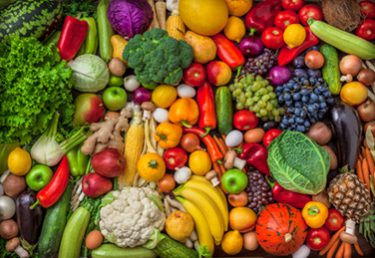
This week, I’m excited to once again have registered dietitian and certified diabetes educator Lori Lehnert as my special guest blogger.
It’s no secret that nutrition is one of the hottest topics this time of year. Everywhere you go, from social media, work, the gym or even relaxing on the couch, you can’t help but be bombarded with the newest trends in nutrition. Let’s take a closer look at some of the more popular nutrition trends to see what the buzz is all about.
Keto – While the concept of a low-carbohydrate/high-fat diet is not a new trend, keto has seen a big resurgence in the past few years. It can feel like everyone from the hottest celebrities to the person in line at the grocery store is talking about this one. So, what’s it all about? An average adult would be limited to about 15-20 grams of carbohydrate a day. There are various modifications of the ketogenic diet that are not quite as restrictive, but the basics are the same—high in fat, moderate in protein and very low in carbohydrate. The idea behind the diet is to change the way you eat to force your body to use ketones from fats as your go-to energy source instead of glucose from carbohydrates. So is this diet right for you? Well, a low-carbohydrate diet boils down to eating fewer carbs than what you would normally eat in a day. For many people, limiting the portion sizes of carbs to the recommended serving sizes is a big enough—and often more of a long-term lifestyle change—to result in a healthier diet and weight.
Whole Foods – Cutting out processed foods and focusing on whole foods means that you’re cutting back on the negative additives that occur in processing like added fats, salts, sugars and trans fats. There are many diets that have a variety of restrictions that go beyond simply incorporating more whole foods and fewer processed foods. Many of these diets restrict certain foods for a period of time to “detox” from these items. Restrictions include no sweeteners (natural or artificial), no alcohol, no grains, no legumes, no soy or dairy, and no “fake treats”—meaning your cauliflower pizza crust is out. Focusing on less processed foods can be a great way to add healthy foods into your diet, but be wary of trends that focus on restricting yourself unnecessarily.
Macros – Counting macros is a more detailed way of monitoring your diet than counting calories. “Macros” refer to macronutrients in your diets: carbohydrates, fats and protein. This type of tracking helps focus on the quality of food you’re taking in, not just the calories. For example, while a cookie might fit into your calories for the day, it likely is too high in carbohydrates and fat and too low in protein to meet your “macros” for that snack. The ratios that are used for macros are based off individual nutrition goals, meaning that a bodybuilder may have a higher-protein ratio than a long-distance runner, who may have a higher carbohydrate ratio than others. While calculators and apps are available to help, many people find that counting macros can be very time consuming and complicated. Adding up the grams of fat and protein in one item and finding a carbohydrate to go with it—without going over your other macros—can be overwhelming! If this level of precision in your diet feels like too much, you can do a modified version by staying in your calorie level and focusing on nutrient-packed foods.
Elimination Diets – Gluten-free, dairy-free and others that eliminate specific food groups are not a new trend, but they’re one that remains strong. For many people with serious health conditions, it’s critical to follow these special diets. However, some people have started following them for weight-loss purposes. Truthfully, cutting out these items does not necessarily mean you will lose weight. The weight loss tends to come from cutting out certain foods that you may have been overindulging on. However, while going gluten-free may have forced you to cut out your pasta, there are gluten-free pastas that you could substitute instead. These substitute products are often higher in fat, carbs or sugar to help with taste and texture. And, sorry, but a deep-fried, gluten-free cheese curd is not any healthier!
While trends may come and go, keep in mind that the ultimate goal of good nutrition is to find a lifestyle that works for you! Also, it’s important to keep in mind that as a diet becomes more popular, new products tend to come out to make following them “easier.” These convenience foods are often highly processed and loaded with salt and unhealthy fats, like trans and saturated fats, that don’t fit into a healthy lifestyle. Start with small, doable changes that will work for YOU!



Thank you for this informative guest post, Lori. I agree with your conclusion–instead of chasing diet fads, we should adhere to healthy, sustainable plans that guide us towards our goals. I do track my daily calories (and protein grams), but I know it’s onerous for some people. We each can decide what fits for our lifestyles.
Hi Robin! I’ll be sure to share your comment with Lori 🙂
Thanks so much, Robin!
Thank You for sharing I enjoyed and learning a lot.
That’s great to hear, Bernice!
Thanks!! I enjoy your work!
Thanks for reading, Libby!
I was so surprised to see Keto! I’ve been eating keto since March 2018. Many great things have happened to me health wise. Thanks for the blog!!!
New to your blog….lovin it already!
What is the recommended amount of carbs per day? I have been on low carb, high protein and it seems to be working for me. I average between 35-50 carbs per day.
Hi Susan,
The general recommendation is 40-50% of your daily calorie needs from carbs. This would be around 140-200 grams of carbs daily for most calorie ranges between 1400-2000 calories a day. Now, of course, this can vary greatly depending on other health conditions or lifestyle needs. I’m glad you are enjoying the blog already! Maggie does a great job of covering a variety of topics!
How do you keep track of your carbs? Is there an ap?
Hi Marsha – TOPS has various tracking tools including a food journal and our popular food exchange cards. We do have an app, but it’s important to know that this app is not a food tracker with an extensive library of food products and their calorie counts. If you’d like to learn more, please don’t hesitate to send an email to wondering@tops.org. Thanks for reading!
I so enjoy these articles and share with our group. I am thankful for the way the information is shared..
I’m thankful for readers like you, Florene!
I really enjoy your blog, and I like to incorporate some of them into a program. It would be helpful if there was an easy way to just print the body of the blog.
Thanks for reading, Pat. I’ll be sure to share your comment with our web team.
I agree – I wish I could print certain parts to share at our meeting.